美国CIR审定在许可条件下使用安全的化妆品原料
- 格式:pdf
- 大小:125.77 KB
- 文档页数:10
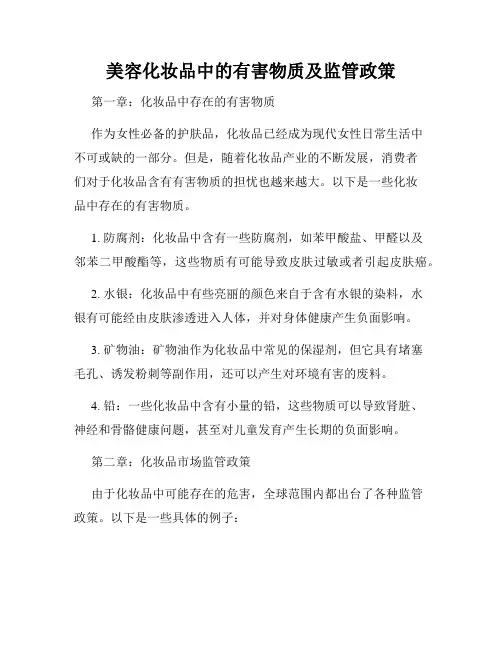
美容化妆品中的有害物质及监管政策第一章:化妆品中存在的有害物质作为女性必备的护肤品,化妆品已经成为现代女性日常生活中不可或缺的一部分。
但是,随着化妆品产业的不断发展,消费者们对于化妆品含有有害物质的担忧也越来越大。
以下是一些化妆品中存在的有害物质。
1. 防腐剂:化妆品中含有一些防腐剂,如苯甲酸盐、甲醛以及邻苯二甲酸酯等,这些物质有可能导致皮肤过敏或者引起皮肤癌。
2. 水银:化妆品中有些亮丽的颜色来自于含有水银的染料,水银有可能经由皮肤渗透进入人体,并对身体健康产生负面影响。
3. 矿物油:矿物油作为化妆品中常见的保湿剂,但它具有堵塞毛孔、诱发粉刺等副作用,还可以产生对环境有害的废料。
4. 铅:一些化妆品中含有小量的铅,这些物质可以导致肾脏、神经和骨骼健康问题,甚至对儿童发育产生长期的负面影响。
第二章:化妆品市场监管政策由于化妆品中可能存在的危害,全球范围内都出台了各种监管政策。
以下是一些具体的例子:1. 美国FDA:美国食品药品监管局规定化妆品必须使用安全无害的成分,如果某一化妆品含有未审批成分或超出允许的成分,将被禁售。
2. 欧盟REACH:欧盟对所有在欧洲市场上销售的化妆品以及其他化学品都实施了REACH法规。
该法规规定了所有化学物质必须经过全面的安全评估,包括在州立机构和非州立机构中进行的测试。
3. 中国国家食品药品监督管理总局:该机构负责检查化妆品的广告宣传,产品质量和海关货物检查,并出口化妆品到国外市场,需要进行美国FDA的审查。
第三章:消费者如何选择安全的化妆品虽然监管部门对化妆品制造商实行严格的监管,但消费者仍然需要对自己使用的化妆品进行仔细的选择,以确保它们是安全的。
以下是一些需要注意的事项:1. 避免高风险化妆品:选择品牌可信的、经过专业测评的、有安全认证的化妆品,避免购买效力夸张不科学,含有激素等高风险成分的产品。
2. 阅读化妆品标签:化妆品标签中包含了所含成分,生产厂商等信息,可以方便消费者做出更科学和正确的选择。
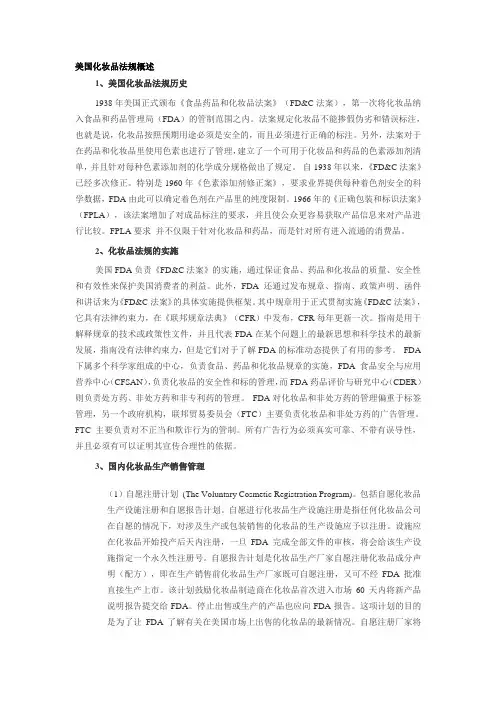
美国化妆品法规概述1、美国化妆品法规历史1938年美国正式颁布《食品药品和化妆品法案》(FD&C法案),第一次将化妆品纳入食品和药品管理局(FDA)的管制范围之内。
法案规定化妆品不能掺假伪劣和错误标注,也就是说,化妆品按照预期用途必须是安全的,而且必须进行正确的标注。
另外,法案对于在药品和化妆品里使用色素也进行了管理,建立了一个可用于化妆品和药品的色素添加剂清单,并且针对每种色素添加剂的化学成分规格做出了规定。
自1938年以来,《FD&C法案》已经多次修正。
特别是1960年《色素添加剂修正案》,要求业界提供每种着色剂安全的科学数据,FDA由此可以确定着色剂在产品里的纯度限制。
1966年的《正确包装和标识法案》(FPLA),该法案增加了对成品标注的要求,并且使公众更容易获取产品信息来对产品进行比较。
FPLA要求并不仅限于针对化妆品和药品,而是针对所有进入流通的消费品。
2、化妆品法规的实施美国FDA负责《FD&C法案》的实施,通过保证食品、药品和化妆品的质量、安全性和有效性来保护美国消费者的利益。
此外,FDA还通过发布规章、指南、政策声明、函件和讲话来为《FD&C法案》的具体实施提供框架。
其中规章用于正式贯彻实施《FD&C法案》,它具有法律约束力,在《联邦规章法典》(CFR)中发布,CFR每年更新一次。
指南是用于解释规章的技术或政策性文件,并且代表FDA在某个问题上的最新思想和科学技术的最新发展,指南没有法律约束力,但是它们对于了解FDA的标准动态提供了有用的参考。
FDA 下属多个科学家组成的中心,负责食品、药品和化妆品规章的实施,FDA食品安全与应用营养中心(CFSAN),负责化妆品的安全性和标的管理,而FDA药品评价与研究中心(CDER)则负责处方药、非处方药和非专利药的管理。
FDA对化妆品和非处方药的管理偏重于标签管理,另一个政府机构,联邦贸易委员会(FTC)主要负责化妆品和非处方药的广告管理。
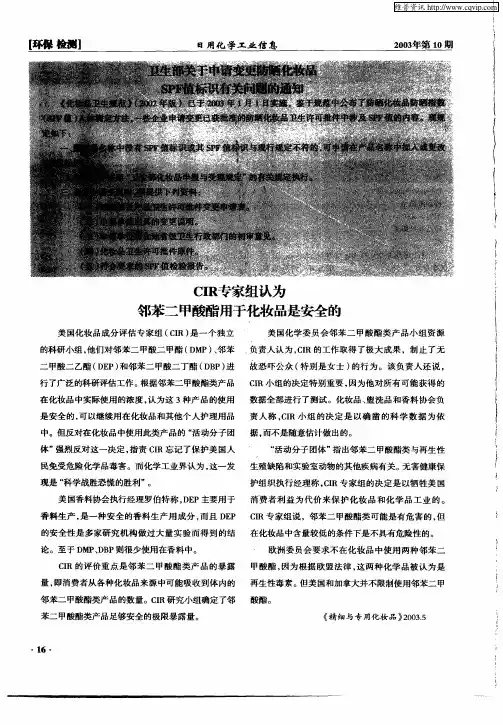
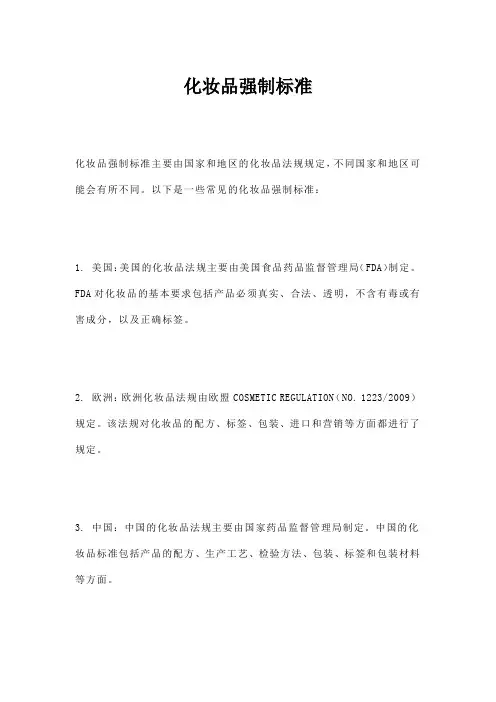
化妆品强制标准
化妆品强制标准主要由国家和地区的化妆品法规规定,不同国家和地区可能会有所不同。
以下是一些常见的化妆品强制标准:
1. 美国:美国的化妆品法规主要由美国食品药品监督管理局(FDA)制定。
FDA对化妆品的基本要求包括产品必须真实、合法、透明,不含有毒或有害成分,以及正确标签。
2. 欧洲:欧洲化妆品法规由欧盟COSMETIC REGULATION(NO. 1223/2009)规定。
该法规对化妆品的配方、标签、包装、进口和营销等方面都进行了规定。
3. 中国:中国的化妆品法规主要由国家药品监督管理局制定。
中国的化妆品标准包括产品的配方、生产工艺、检验方法、包装、标签和包装材料等方面。
4. 日本:日本的化妆品法规主要由厚生劳动省制定。
日本的化妆品标准
包括产品的配方、生产工艺、检验方法、包装、标签和包装材料等方面。
以上这些标准主要是为了保障化妆品的安全和有效性,保护消费者的健康。
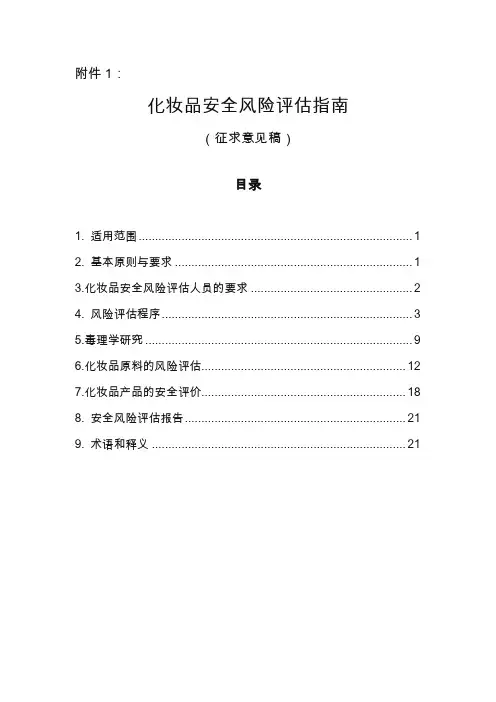
附件1:化妆品安全风险评估指南(征求意见稿)目录1. 适用范围 (1)2. 基本原则与要求 (1)3.化妆品安全风险评估人员的要求 (2)4. 风险评估程序 (3)5.毒理学研究 (9)6.化妆品原料的风险评估 (12)7.化妆品产品的安全评价 (18)8. 安全风险评估报告 (21)9. 术语和释义 (21)化妆品安全风险评估指南为保证消费者的健康安全,识别和控制化妆品安全风险,制定本指南。
1. 适用范围适用于化妆品原料的风险评估和产品的安全评价,包括由原料或产品生产过程中不可避免带入的安全性风险物质的风险评估。
2. 基本原则与要求2.1化妆品一般可认为是各种原料的组合,原料的安全性是化妆品安全的前提条件。
化妆品的安全性评价应基于所有原料和风险物质的风险评估。
如果确认某些原料之间存在化学、生物学等相互作用的,应该对其产生的风险物质进行评估。
2.2化妆品安全性评价应以现有科学数据和相关信息为基础,遵循科学、公正、透明和个案处理的原则,在实施过程中应保证风险评估工作的独立性。
2.3化妆品的安全风险评估工作由具有相应资质的安全风险评估人员按照本指南的要求进行评价,并出具风险评估报告。
2.4化妆品产品的安全风险评估资料应当及时更新,并保留至最后一批上市产品保质期结束以后10年。
2.5化妆品安全风险评估报告结论不足以排除产品对人体健康存在风险的,应当采用传统毒理学试验方法进行产品安全性评价。
3.化妆品安全风险评估人员的要求化妆品安全风险评估人员应符合以下要求:3.1具有化妆品专业知识基础,了解化妆品生产过程和质量安全控制要求;3.2能够查阅和分析毒理学信息,具有分析、评价和解释毒理学数据的能力;3.3能够公平、客观的分析化妆品的安全性,在全面分析所有可获得的数据和暴露条件的基础上,开展风险评估工作;3.4应当具有医学、药学、化学、毒理学或者类似学科的专业基础,取得大学本科以上文凭或其他正式资格证明,并具有5年以上相关专业从业经历。
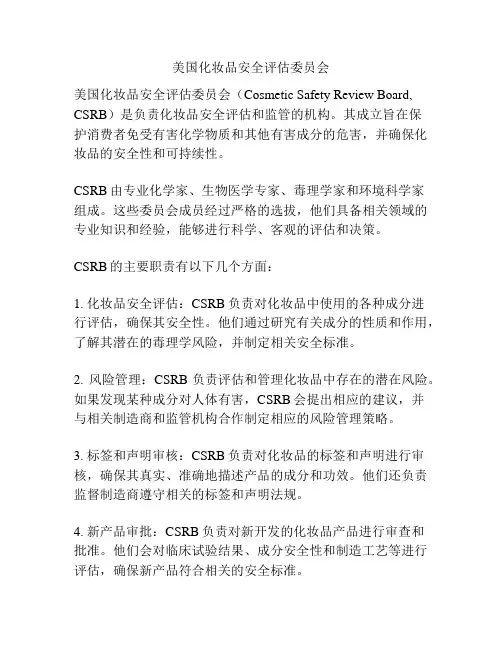
美国化妆品安全评估委员会美国化妆品安全评估委员会(Cosmetic Safety Review Board, CSRB)是负责化妆品安全评估和监管的机构。
其成立旨在保护消费者免受有害化学物质和其他有害成分的危害,并确保化妆品的安全性和可持续性。
CSRB由专业化学家、生物医学专家、毒理学家和环境科学家组成。
这些委员会成员经过严格的选拔,他们具备相关领域的专业知识和经验,能够进行科学、客观的评估和决策。
CSRB的主要职责有以下几个方面:1. 化妆品安全评估:CSRB负责对化妆品中使用的各种成分进行评估,确保其安全性。
他们通过研究有关成分的性质和作用,了解其潜在的毒理学风险,并制定相关安全标准。
2. 风险管理:CSRB负责评估和管理化妆品中存在的潜在风险。
如果发现某种成分对人体有害,CSRB会提出相应的建议,并与相关制造商和监管机构合作制定相应的风险管理策略。
3. 标签和声明审核:CSRB负责对化妆品的标签和声明进行审核,确保其真实、准确地描述产品的成分和功效。
他们还负责监督制造商遵守相关的标签和声明法规。
4. 新产品审批:CSRB负责对新开发的化妆品产品进行审查和批准。
他们会对临床试验结果、成分安全性和制造工艺等进行评估,确保新产品符合相关的安全标准。
除了以上职责,CSRB还与其他机构合作,加强化妆品行业的监管和标准制定。
他们与食品药品监管局(FDA)、环境保护局(EPA)等部门密切合作,共同推动化妆品安全和可持续发展的进程。
总之,美国化妆品安全评估委员会负责化妆品的安全评估和监管工作,致力于保护消费者的健康和权益。
他们的工作对化妆品行业的可持续发展起着重要的推动和引领作用。
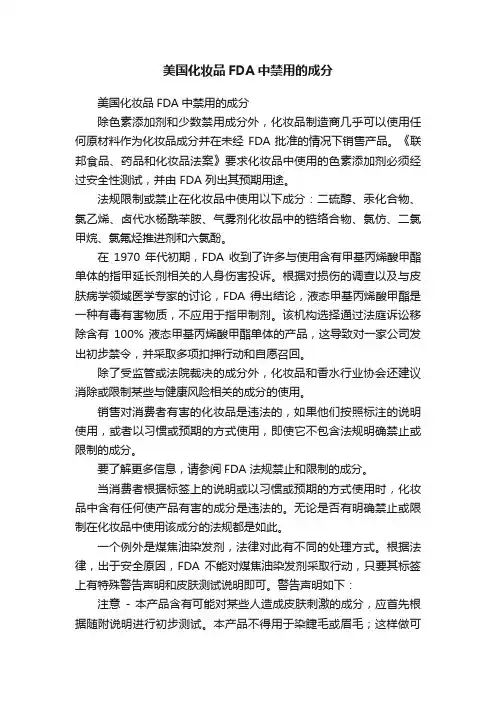
美国化妆品FDA中禁用的成分美国化妆品FDA中禁用的成分除色素添加剂和少数禁用成分外,化妆品制造商几乎可以使用任何原材料作为化妆品成分并在未经 FDA 批准的情况下销售产品。
《联邦食品、药品和化妆品法案》要求化妆品中使用的色素添加剂必须经过安全性测试,并由 FDA 列出其预期用途。
法规限制或禁止在化妆品中使用以下成分:二硫醇、汞化合物、氯乙烯、卤代水杨酰苯胺、气雾剂化妆品中的锆络合物、氯仿、二氯甲烷、氯氟烃推进剂和六氯酚。
在1970 年代初期,FDA 收到了许多与使用含有甲基丙烯酸甲酯单体的指甲延长剂相关的人身伤害投诉。
根据对损伤的调查以及与皮肤病学领域医学专家的讨论,FDA 得出结论,液态甲基丙烯酸甲酯是一种有毒有害物质,不应用于指甲制剂。
该机构选择通过法庭诉讼移除含有100% 液态甲基丙烯酸甲酯单体的产品,这导致对一家公司发出初步禁令,并采取多项扣押行动和自愿召回。
除了受监管或法院裁决的成分外,化妆品和香水行业协会还建议消除或限制某些与健康风险相关的成分的使用。
销售对消费者有害的化妆品是违法的,如果他们按照标注的说明使用,或者以习惯或预期的方式使用,即使它不包含法规明确禁止或限制的成分。
要了解更多信息,请参阅FDA 法规禁止和限制的成分。
当消费者根据标签上的说明或以习惯或预期的方式使用时,化妆品中含有任何使产品有害的成分是违法的。
无论是否有明确禁止或限制在化妆品中使用该成分的法规都是如此。
一个例外是煤焦油染发剂,法律对此有不同的处理方式。
根据法律,出于安全原因,FDA 不能对煤焦油染发剂采取行动,只要其标签上有特殊警告声明和皮肤测试说明即可。
警告声明如下:注意- 本产品含有可能对某些人造成皮肤刺激的成分,应首先根据随附说明进行初步测试。
本产品不得用于染睫毛或眉毛;这样做可能会导致失明。

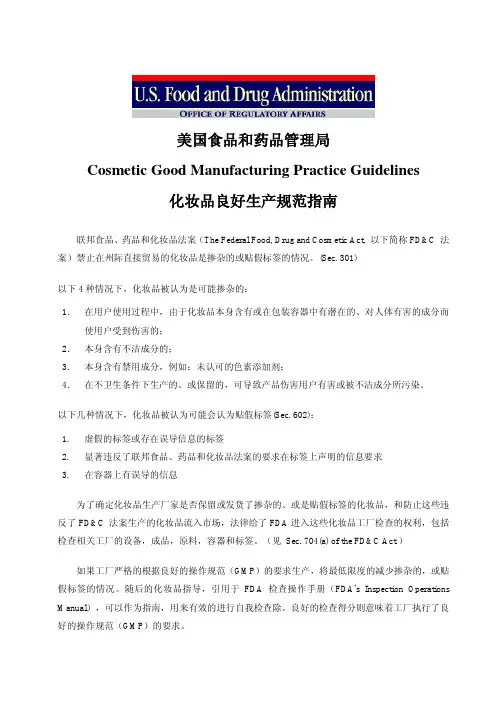
美国食品和药品管理局Cosmetic Good Manufacturing Practice Guidelines化妆品良好生产规范指南联邦食品、药品和化妆品法案(The Federal Food, Drug and Cosmetic Act, 以下简称FD&C 法案)禁止在州际直接贸易的化妆品是掺杂的或贴假标签的情况。
(Sec. 301)以下4种情况下,化妆品被认为是可能掺杂的:1.在用户使用过程中,由于化妆品本身含有或在包装容器中有潜在的、对人体有害的成分而使用户受到伤害的;2.本身含有不洁成分的;3.本身含有禁用成分,例如:未认可的色素添加剂;4.在不卫生条件下生产的、或保留的,可导致产品伤害用户有害或被不洁成分所污染。
以下几种情况下,化妆品被认为可能会认为贴假标签(Sec. 602):1.虚假的标签或存在误导信息的标签2.显著违反了联邦食品、药品和化妆品法案的要求在标签上声明的信息要求3.在容器上有误导的信息为了确定化妆品生产厂家是否保留或发货了掺杂的、或是贴假标签的化妆品,和防止这些违反了FD&C 法案生产的化妆品流入市场,法律给了FDA进入这些化妆品工厂检查的权利,包括检查相关工厂的设备,成品,原料,容器和标签。
(见Sec. 704(a) of the FD&C Act.)如果工厂严格的根据良好的操作规范(GMP)的要求生产,将最低限度的减少掺杂的,或贴假标签的情况。
随后的化妆品指导,引用于FDA检查操作手册(FDA's Inspection Operations Manual),可以作为指南,用来有效的进行自我检查除。
良好的检查得分则意味着工厂执行了良好的操作规范(GMP)的要求。
指南1.建筑物和设施:检查是否a.用于生产或存放化妆品的建筑物应大小合适,设计和结构应保证设备进出不受阻碍,材料存放整洁,操作卫生以及正确的清洁和维护;b.地面,墙壁和天花板结构表面应光滑,易于清洁,并保持干净和良好状况;c.安装的固定装置,管道的滴水或者冷凝水不会污染化妆品原料,器具,以及与化妆品原料,散装产品或成品接触的设备的表面;d.照明和排风系统应满足预期员工操作和舒适的要求;e.供水,清洗和卫生设施,地面排水和废水系统应充分满足清洁操作的要求,和设备、器具的清洁要求,以及满足员工的需要并易于让员工保持个人清洁2.设备:检查是否a.加工、盛放、中转和灌装过程使用的设备和器具应设计合理,使用的材料和工艺能防止腐蚀、污垢的堆积、以及被润滑油、灰尘或者消毒剂污染;b.器具,运送管道以及和化妆品接触的设备表面应维护良好,并定期清洁和消毒;c.清洁和消毒后的便携式设备和器具应妥善放置,与化妆品接触的设备表面应罩住,以防止飞溅,灰尘或其他污染物3.员工: 检查是否a.监督化妆品的生产或者控制的员工应具有一定的教育背景,培训和/或经验来执行指定的监督工作;b.为防止化妆品掺杂,与化妆品原料,散装成品或化妆品接触表面直接接触的员工,应穿戴适合的工作服,手套,头套等,并保持良好的个人清洁;c.吃东西,喝水,或者抽烟都应严格限制在制定的区域。
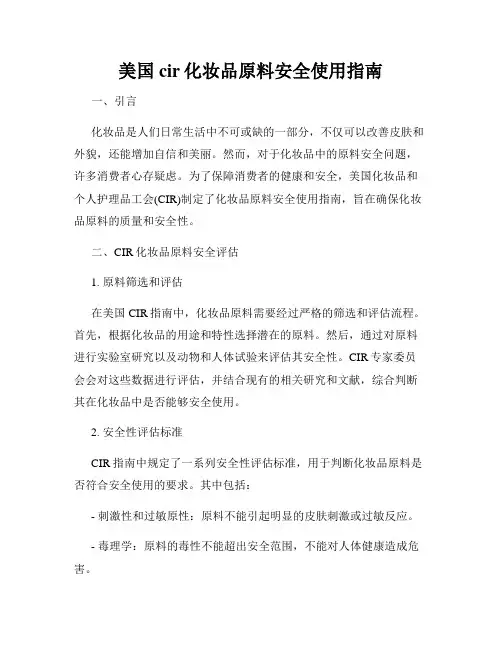
美国cir化妆品原料安全使用指南一、引言化妆品是人们日常生活中不可或缺的一部分,不仅可以改善皮肤和外貌,还能增加自信和美丽。
然而,对于化妆品中的原料安全问题,许多消费者心存疑虑。
为了保障消费者的健康和安全,美国化妆品和个人护理品工会(CIR)制定了化妆品原料安全使用指南,旨在确保化妆品原料的质量和安全性。
二、CIR化妆品原料安全评估1. 原料筛选和评估在美国CIR指南中,化妆品原料需要经过严格的筛选和评估流程。
首先,根据化妆品的用途和特性选择潜在的原料。
然后,通过对原料进行实验室研究以及动物和人体试验来评估其安全性。
CIR专家委员会会对这些数据进行评估,并结合现有的相关研究和文献,综合判断其在化妆品中是否能够安全使用。
2. 安全性评估标准CIR指南中规定了一系列安全性评估标准,用于判断化妆品原料是否符合安全使用的要求。
其中包括:- 刺激性和过敏原性:原料不能引起明显的皮肤刺激或过敏反应。
- 毒理学:原料的毒性不能超出安全范围,不能对人体健康造成危害。
- 致癌性和致突变性:原料不能具有致癌或致突变的潜力。
- 紫外线吸收剂:原料不能损害皮肤对紫外线的自我防护能力,同时不能对环境造成危害。
这些严格的评估标准确保了化妆品原料的安全性和可靠性。
三、CIR指南的应用1. 原料商和生产商CIR指南对原料商和生产商具有重要的指导作用。
原料商需要遵循CIR指南的原料选择和安全性评估标准,确保提供的原料符合最新的安全标准。
生产商则需要根据CIR指南,选用经过评估合格的原料,以确保最终产品的安全性。
2. 监管部门CIR指南也是监管部门进行化妆品审核和监督的重要参考。
监管部门可以依据CIR指南的评估结果,对化妆品市场进行监督和管理,确保市面上的化妆品符合安全使用的要求。
3. 消费者对于消费者而言,CIR指南提供了一个参考标准,用于选择安全可靠的化妆品。
消费者在购买化妆品时可以查看产品的成分表,确认是否有CIR指南中列出的原料。
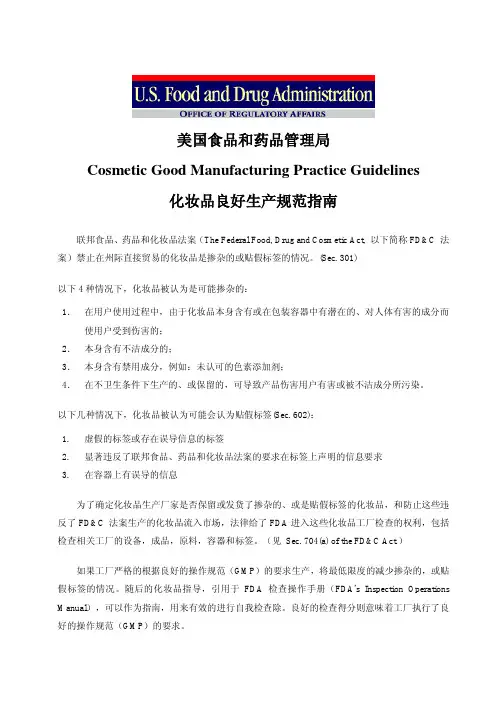
美国食品和药品管理局Cosmetic Good Manufacturing Practice Guidelines化妆品良好生产规范指南联邦食品、药品和化妆品法案(The Federal Food, Drug and Cosmetic Act, 以下简称FD&C 法案)禁止在州际直接贸易的化妆品是掺杂的或贴假标签的情况。
(Sec. 301)以下4种情况下,化妆品被认为是可能掺杂的:1.在用户使用过程中,由于化妆品本身含有或在包装容器中有潜在的、对人体有害的成分而使用户受到伤害的;2.本身含有不洁成分的;3.本身含有禁用成分,例如:未认可的色素添加剂;4.在不卫生条件下生产的、或保留的,可导致产品伤害用户有害或被不洁成分所污染。
以下几种情况下,化妆品被认为可能会认为贴假标签(Sec. 602):1.虚假的标签或存在误导信息的标签2.显著违反了联邦食品、药品和化妆品法案的要求在标签上声明的信息要求3.在容器上有误导的信息为了确定化妆品生产厂家是否保留或发货了掺杂的、或是贴假标签的化妆品,和防止这些违反了FD&C 法案生产的化妆品流入市场,法律给了FDA进入这些化妆品工厂检查的权利,包括检查相关工厂的设备,成品,原料,容器和标签。
(见Sec. 704(a) of the FD&C Act.)如果工厂严格的根据良好的操作规范(GMP)的要求生产,将最低限度的减少掺杂的,或贴假标签的情况。
随后的化妆品指导,引用于FDA检查操作手册(FDA's Inspection Operations Manual),可以作为指南,用来有效的进行自我检查除。
良好的检查得分则意味着工厂执行了良好的操作规范(GMP)的要求。
指南1.建筑物和设施:检查是否a.用于生产或存放化妆品的建筑物应大小合适,设计和结构应保证设备进出不受阻碍,材料存放整洁,操作卫生以及正确的清洁和维护;b.地面,墙壁和天花板结构表面应光滑,易于清洁,并保持干净和良好状况;c.安装的固定装置,管道的滴水或者冷凝水不会污染化妆品原料,器具,以及与化妆品原料,散装产品或成品接触的设备的表面;d.照明和排风系统应满足预期员工操作和舒适的要求;e.供水,清洗和卫生设施,地面排水和废水系统应充分满足清洁操作的要求,和设备、器具的清洁要求,以及满足员工的需要并易于让员工保持个人清洁2.设备:检查是否a.加工、盛放、中转和灌装过程使用的设备和器具应设计合理,使用的材料和工艺能防止腐蚀、污垢的堆积、以及被润滑油、灰尘或者消毒剂污染;b.器具,运送管道以及和化妆品接触的设备表面应维护良好,并定期清洁和消毒;c.清洁和消毒后的便携式设备和器具应妥善放置,与化妆品接触的设备表面应罩住,以防止飞溅,灰尘或其他污染物3.员工: 检查是否a.监督化妆品的生产或者控制的员工应具有一定的教育背景,培训和/或经验来执行指定的监督工作;b.为防止化妆品掺杂,与化妆品原料,散装成品或化妆品接触表面直接接触的员工,应穿戴适合的工作服,手套,头套等,并保持良好的个人清洁;c.吃东西,喝水,或者抽烟都应严格限制在制定的区域。
Cosmetic ingredients found safe as used (1374 total, through July 2011)Ingredient#"As used" concentration for safe as usedconclusionAcacia Senegal Gum and Acacia Senegal Gum Extract 2 up to 9%Acetic Acid 1 up to 0.3%Acetylated Lanolin 1 up to 7%Acetylated Lanolin Alcohol 1 up to 16%Acetyl Tributyl Citrate 1 up to 7%Acetyl Triethyl Citrate 1 up to 7%Acetyl Trihexyl Citrate 1 not in use at the time*Acetyl Trioctyl Citrate 1 not in use at the time*Acrylates/Dimethiconol Acrylate Copolymer (Dimethiconol and its Esters and Reaction Products) 1 up to 0.5%Actinidia Chinensis (Kiwi) Seed Oil 1 up to 0.1%Adansonia Digitata Oil 1 up to 0.01%Adansonia Digitata Seed Oil 1 not in use at the time*Adipic Acid (Dicarboxylic Acids and their Salts and Esters) 1 0.000001% in leave on; 18% in rinse off4 up to 99%Alcohol Denat. denatured with t-Butyl Alcohol, Denatonium Benzoate, Diethyl Phthalate, or MethylAlcoholAleurites Moluccanus Bakoly Seed Oil 1 not in use at the time*Aleurities Moluccana Seed Oil 1 0.00001 to 5%Allantoin 1 up to 2%Allantoin Ascorbate 1 up to 0.05%Allantoin Biotin and Allantoin Galacturonic Acid 2 not in use at the time*Allantoin Glycyrrhetinic Acid, Allantoin Panthenol, and Allantoin Polygalacturonic Acid 3 concentration not reported*Alumnina Magnesium Silicate 1 up to 0.01%Alumnium Calcium Silicate 1 up to 6%Aluminum Dimyristate 1 up to 3%Aluminum Distearate 1 up to 5%Aluminum Iron Silicates 1 not in use at the time*13 not in use at the time*Aluminum Isostearates/Myristates, Calcium Myristate, Decyl Myristate, Ethylhexyl Myristate, EthylMyristate, Glyceryl Dimyristate, Glyceryl Isostearate/Myristate, Isostearyl Myristate, IsotridecylMyristate, Methyl Myristate, Oleyl Myristate, Tetradecyloctadecyl Myristate, Tridecyl MyristateAluminum Myristate 1 up to 1%Alumnium Myristates/Palmitates 1 up to 6%Aluminum Silicate 1 up to 37% in dentifrices; up to 3% in other usesAluminum Stearate 1 up to 8%Aluminum Tristearate 1 up to 10%Amaranthus Hypochondriacus Seed Oil 1 not in use at the time*Amino Bispropyl Dimethicone 1 not in use at the time*5-Amino-4-Chloro-o-Cresol 1 up to 2% in oxidative and non-oxidative hair dyes5-Amino-6-Chloro-o-Cresol 1 up to 2% in oxidative and non-oxidative hair dyes4-Amino-m-Cresol 1 up to 0.7% in oxidative and non-oxidative hair dyes6-Amino-m-Cresol 1 up to 2.4% in oxidative and non-oxidative hair dyes6-Amino-o-Cresol 1 up to 0.7% in oxidative hair dyes; insufficient data foruse in non-oxidative hair dyes4-Amino-2-Hydroxytoluene 1 up to 5%Aminomethyl Propanediol 1 up to 2%Aminomethyl Propanol 1 up to 7%2-Amino-3-Nitrophenol 1 up to 2%concentration not reported*2-Amino-4-Nitrophenol 1 2-Amino-4-Nitrophenol Sulfate 1 not in use at the time*2-Amino-5-Nitrophenol 1 not in use at the time*Cosmetic Ingredient Review, 1101 17th Street, NW, Suite 310, Washington, DC 20036 ph 202.331.0651 fax 202.331.0088 email info@Ingredient#"As used" concentration for safe as usedconclusion4-Amino-3-Nitrophenol 1 up to 9%m-Aminophenol 1 up to 5%o-Aminophenol 1 up to 1%p-Aminophenol 1 up to 1%Aminopropyl Dimethicone 1 not in use at the time*Ammonium Bisulfite 1 up to 32%Ammonium Capryleth Sulfate, Ammonium c12-15 Pareth Sulfate, Ammonium Myreth Sulfate,10 not in use at the time*Magnesium Coceth Sulfate, Magnesium Myreth Sulfate, Sodium C10-15 Pareth Sulfate, SodiumC12-13 Pareth Sulfate, Dodium Deceth Sulfate, Sodium Laneth Sulfate, Zinc Coceth SulfateAmmonium Cocomonoglyceride Sulfate, Coconut Oil Decyl Esters, Decyl Cocoate, Hydrogenated11 not in use at the time*Coco-Glycerides, Isodecyl Cocoate, Lauryl Cocoate, Octyldodecyl Cocoate, PotassiumHydrogenated Cocoate, Sodium Cocomonoglyceride Sulfate, Sodium Hydrogenated Cocoate, andTridecyl Cocoate9 not in use at the time*Ammonium Coco-Sulfate, Ammonium Myristyl Sulfate, Magnesium Coco-Sulfate, SodiumCoco/Hydrogenated Tallow Sulfate, Sodium Ethylhexyl Sulfate, Sodium Oleyl Sulfate, SodiumTallow Sulfate, Sodium Tridecyl Sulfate, Zinc Coco-SulfateAmmonium Cumenesulfonate 1 not in use at the time*Ammonium Glycyrrhizate 1 up to 5%Ammonium Laureth Sulfate 1 up to 36%Ammonium Stearate 1 up to 10%Ammonium Sulfite 1 not in use at the time*Ammonium Tallate 1 not in use at the time*Ammonium Xylenesulfonate 1 up to 3%Amodimethicone 1 up to 3%Amodimethicone Hydroxystearate 1 not in use at the time*Amyl Acetate 1 up to 10%Amyl Benzoate 1 not in use at the time*Anacardium Occidentale (Cashew) Seed Oil 1 0.002 to 1%Arachidyl Glycol 1 not in use at the time*Arachidyl Propionate 1 up to 10%Arachis Hypogaea (Peanut) Oil 1 0.0001 to 30%Arctium Lappa Seed Oil 1 not in use at the time*Argania Spinosa Kernel Oil 1 0.001 to 10%Ascorbic Acid 1 up to 35% (formulated to be non-irritating) Ascorbyl Dipalmitate 1 not in use at the time*Ascorbyl Palmitate 1 up to 0.2%Ascorbyl Stearate 1 not in use at the time*Astragalus Gummifer Gum (aka Tragacanth (Astragalus Gummifer) Gum) 1 up to 3%Astrocaryum Murumuru Seed Butter 1 0.001 to 7%Attapulgite 1 up to 8%Avena Sativa (Oat) Kernel Oil 1 0.002 to 0.005%Avocado Oil (aka Persea Gratissima (Avocado) Oil) 1 0.0001 to 98%Azelaic Acid (Dicarboxylic Acids and their Salts and Esters) 1 up to 0.3% in leave on; 10% in rinse off Babassu Acid 1 not in use at the time*Basic Blue 99 1 up to 2%Bassia Butyracea Seed Butter 1 not in use at the time*Bassia Latifolia Seed Butter 1 0.001 to 2%Beeswax 1 up to 56%Behenoxy Dimethicone 1 up to 3%Behenyl Alcohol 1 up to 50%Behenyl Benzoate 1 not in use at the time*Cosmetic Ingredient Review, 1101 17th Street, NW, Suite 310, Washington, DC 20036 ph 202.331.0651 fax 202.331.0088 email info@Ingredient#"As used" concentration for safe as usedconclusionBentonite 1 12-80% in mud packs; up to 8% for other uses Benzaldehyde 1 up to 0.5%Benzophenone-1 1 up to 2%Benzophenone-2 1 up to 6%Benzophenone-3 1 up to 7%Benzophenone-4 1 up to 2.5%Benzophenone-5, -6 2 up to 0.3%Benzophenone-8 1 up to 0.2%Benzophenone-9 1 up to 0.4%Benzophenone-11 1 up to 0.2%Benzylparaben 1 up to 0.4% if used alone (paraben mixes up to 0.8%) Bertholletia Excelsa Seed Oil 1 0.0003 to 0.5%BHA (aka Butylated Hydroxyanisole) 1 up to 0.2%BHT (Butylated Hydroxytoluene) 1 up to 0.5%Biotin 1 up to 1%Bisabolol 1 up to 1%N,N-Bis(2-Hydroxyethyl)-p- Phenylenediamine Sulfate 1 up to 5%Borago Officinalis Seed Oil 1 0.001 to 1%Brassica Campestris (Rapeseed) Oil Unsaponifiables 1 not in use at the time*Brassica Campestris (Rapeseed) Seed Oil 1 0.007 to 17%Brassica Napus Seed Oil 1 not in use at the time*Brassica Oleracea Acephala Seed Oil 1 not in use at the time*Brassica Oleracea Italica (Broccoli) Seed Oil 1 0.001 to 3%n-Butane (aka Butane) 1 up to 92%1,2-Butanediol 1 not in use at the time*Butoxyethyl Acetate 1 not in use at the time*Butyl Acetate 1 up to 72%t-Butyl Acetate 1 Up to 10%n-Butyl Alcohol 1 up to 15% in nail products and 0.002% in otherproductst-Butyl Alcohol 1 up to 0.5%Butyl Benzoate 1 not in use at the time*Butyl Benzyl Phthalate 1 not in use at the time*50%Butylene Glycol 1 >Butylene Glycol Cocoate 1 up to 2%Butylene Glycol Diisononanoate 1 17%Butyl Ester of PVM/MA Copolymer 1 up to 14%Butyl Myristate 1 concentration not reported*Butyloctyl Benzoate 1 not in use at the time*Butylparaben 1 up to 0.4% if used alone (paraben mixes up to 0.8%) Butyl Stearate 1 up to 9%Butyrospermum Parkii (Shea) Butter 1 0.0005 to 60%Butyrospermum Parkii (Shea) Butter Unsaponifiables 1 0.06 to 3%Butyrospermum Parkii (Shea) Oil 1 0.01 to 15%C12-15 Alkyl Benzoate 1 0.0008-59%C14-18 Glycol 1 not in use at the time*C15-18 Glycol 1 concentration not reported*C16-17 Alkyl Benzoate 1 concentration not reported*C18-30 Glycol 1 not in use at the time*C20-30 Glycol 1 not in use at the time*Cosmetic Ingredient Review, 1101 17th Street, NW, Suite 310, Washington, DC 20036 ph 202.331.0651 fax 202.331.0088 email info@Ingredient#"As used" concentration for safe as usedconclusionC30-45 Alkyl Dimethicone 1 2%C24-28 Alkyl Methicone 1 not in use at the time*C30-45 Alkyl Methicone 1 not in use at the time*Calcium Acetate 1 concentration not reported*Calcium Ascorbate 1 not in use at the time*Calcium Carboxymethyl Cellulose 1 not in use at the time*Calcium Disodium EDTA 1 not in use at the time*Calcium Silicate 1 up to 10%Calcium Sodium PVM/MA Copolymer 1 concentration not reported*Calcium Stearate 1 up to 23%Calcium Xylenesulfonate 1 not in use at the time*Calendula Officinalis Extract 1 not in use at the time*Calendula Officinalis Flower 1 not in use at the time*Calendula Officinalis Flower Extract 1 up to 6%Calendula Officinalis Flower Oil 1 up to 0.1%Calendula Officinalis Seed Oil 1 not in use at the time*Camelina Sativa Seed Oil 1 0.002 to 1%Camellia Japonica Seed Oil 1 0.01 to 0.2%Camellia Kissi Seed Oil 1 0.1 to 10%Camellia Oleifera Seed Oil 1 0.003 to 3%Camellia Sinensis Seed Oil 1 up to 0.1%Canarium Indicum Seed Oil 1 not in use at the time*Canola Oil 1 0.0002 to 73%Canola Oil Unsaponifiables 1 up to 0.001%Caprylic/Capric Triglyceride 1 up to 84%Caprylic/Capric/Coco Glycerides 1 up to 4%Caprylyl Glycol 1 0.00003 – 5%Carbomer-910, -962 2 not in use at the time*Carbomer-934, -934P, -940, -941 4 up to 2%Carica Papaya Seed Oil 1 up to 0.1%Carthamus Tinctorius (Safflower) Seed Oil 1 0.00005 to 84%Carya Illinoensis (Pecan) Seed Oil 1 not in use at the time*Caryocar Brasiliense Fruit Oil 1 0.0005-0.2Cellobiose Octanonanoate 1 not in use at the time*Cellulose 1 up to 88%Cellulose Acetate 1 up to 2%Cellulose Acetate Butyrate 1 up to 15%Cellulose Acetate Propionate 1 not in use at the time*Cellulose Gum 1 up to 20%Cellulose Succinate 1 not in use at the time*Ceresin 1 up to 20%Cetearyl Alcohol 1 up to 25%Cetearyl Isononanoate 1 up to 50%Cetearyl Methicone 1 up to 1%Cetearyl Nononoate 1 up to 3%Cetearyl Octanoate (aka Cetearyl Ethylhexanoate) 1 up to 25%Cetyl Acetate 1 up to 17%Cetyl Alcohol 1 up to 50%Cetyl Dimethicone 1 up to 10%Cetyl Esters 1 up to 7%Cosmetic Ingredient Review, 1101 17th Street, NW, Suite 310, Washington, DC 20036 ph 202.331.0651 fax 202.331.0088 email info@Ingredient#"As used" concentration for safe as usedconclusionCetyl Glycol 1 not in use at the time*Cetyl Hydroxyethylcellulose 1 up to 2%Cetyl Isononanoate 1 up to 5%Cetyl Myristate 1 up to 6%Cetyl Palmitate 1 up to 11%Cetyl Ricinoleate 1 up to 10%Cetyl Stearate 1 up to 15%Chenopodium Quinoa Seed Oil 1 up to 0.3%4-Chloro-2-Aminophenol 1 safe as used in oxidative hair dyes, but not in use atthe time*; insufficient data for use in non-oxidativehair dyes2-Chloro-p-Phenylenediamine 1 up to 0.1%2-Chloro-p-Phenylenediamine Sulfate 1 up to 1.0%4-Chlororesorcinol 1 ≤1% in hair dyesChloroxylenol 1 up to 0.5%Cholesterol 1 up to 3%Cholesteryl Nonanoate 1 up to 30%Choleth-24 1 up to 5% topicalCitrullus Lanatus (Watermelon) Seed Oil 1 up to 2%Citrus Aurantifolia (Lime) Seed Oil 1 not in use at the time*Citrus Aurantifolia (Lime) Seed Oil Unsaponifiables 1 not in use at the time*Citrus Aurantium Dulcis (Orange) Seed Oil 1 not in use at the time*Citrus Aurantium Dulcis (Orange) Seed Oil Unsaponifiables 1 not in use at the time*Citrus Grandis (Grapefruit) Seed Oil 1 not in use at the time*Citrus Grandis (Grapefruit) Seed Oil Unsaponifiables 1 not in use at the time*Citrus Limon (Lemon) Seed Oil 1 1 to 5%Citrus Paradisi (Grapefruit) Seed Oil 1 0.01 to 20%Cocoamphoacetate (aka Sodium Cocoamphoacetate) 1 up to 10%Cocoamphodiacetate (aka Disodium Cocoamphodiacetate) 1 up to 50%Cocoamphodipropionate (aka Disodium Cocoamphodipropionate) 1 up to 25%Cocoamphopropionate (aka Sodium Cocoamphopropionate) 1 not in use at the time*Cocoglycerides 1 up to 14%Coconut Acid 1 0.03 to 14%Coconut Alcohol 1 up to 0.9%Cocos Nucifera (Coconut) Oil 1 0.0001 to 80%Cocos Nucifera (Coconut) Seed Butter 1 not in use at the time*Coix Lacryma-Jobi (Job’s Tears) Seed Oil 1 not in use at the time*Copernicia Cerifera (Carnauba) Wax 1 up to 20%Corn Acid 1 not in use at the time*Corn Glycerides 1 not in use at the time*Corylus Americana (Hazel) Seed Oil 1 concentration not reported*Corylus Avellana (Hazel) Seed Oil 1 0.005 to 98%Cottonseed Acid 1 not in use at the time*Crambe Abyssinica Seed Oil 1 concentration not reported*Cucumis Sativus (Cucumber) Seed Oil 1 concentration not reported*Cucurbita Pepo (Pumpkin) Seed Oil 1 0.003 to 0.1%Cyclomethicone 1 up to 89%Cycloheptasiloxane 1 concentration not reported* Cyclohexasiloxane 1 up to 48%Cyclopentasiloxane 1 up to 93%Cosmetic Ingredient Review, 1101 17th Street, NW, Suite 310, Washington, DC 20036 ph 202.331.0651 fax 202.331.0088 email info@Ingredient#"As used" concentration for safe as usedconclusionCyclotetrasiloxane 1 up to 28%Cynara Cardunculus Seed Oil 1 not in use at the time*Decylene Glycol 1 concentration not reported*Decyl Oleate 1 up to 88%Decyl Succinate (Dicarboxylic Acids and their Salts and Esters) 1 not in use at the time*Dehydroacetic Acid 1 up to 0.7%Denatonium Benzoate 1 1/16 avoidupois ounce per 100 gal alcohol2,4-Diaminophenoxyethanol Dihydrochloride and 2,4-Diaminophenoxyethanol Sulfate 2 up to 2%Diammonium EDTA 1 not in use at the time*Dibehenyl Fumarate 1 not in use at the time*Dibutyl Adipate (Dicarboxylic Acids and their Salts and Esters) 1 concentration currently not reported;* previouslyreported up to 8%Dibutyloctyl Sebacate (Dicarboxylic Acids and their Salts and Esters) 1 not in use at the time*Dibutyl Phthalate 1 up to 15%Dibutyl Sebacate (Dicarboxylic Acids and their Salts and Esters) 1 not in use at the time*Di-C12-15 Alkyl Adipate (Dicarboxylic Acids and their Salts and Esters) 1 not in use at the time*Di-C12-15 Alkyl Fumarate 1 up to 5%Dicapryl Adipate (Dicarboxylic Acids and their Salts and Esters) 1 concentration not reported*Dicaprylyl/Capryl Sebacate (Dicarboxylic Acids and their Salts and Esters) 1 not in use at the time*Dicapryl Succinate (Dicarboxylic Acids and their Salts and Esters) 1 concentration not reported*Dicetearyl Dimer Dilinoleate 1 up to 7%Dicetearyl Succinate (Dicarboxylic Acids and their Salts and Esters) 1 not in use at the time*Dicetyl Adipate (Dicarboxylic Acids and their Salts and Esters) 1 not in use at the time*Diethyl Adipate (Dicarboxylic Acids and their Salts and Esters) 1 not in use at the time*Diethylene Glycol Diethylhexanoate/Diisononanoate 1 up to 19%Diethylene Glycol Diisononanoate 1 not in use at the time*Diethylhexyl Adipate (aka Dioctyl Adipate) (Dicarboxylic Acids and their Salts and Esters) 1 up to 14% in leave on; 0.6% in rinse off Diethylhexyl Dimer Dilinoleate (aka Dioctyl Dimer Dilinoleate) 1 up to 12%Diethylhexyl Fumarate 1 not in use at the time*Diethylhexyl Sodium Sulfosuccinate (aka Dioctyl Sodium Sulfosuccinate) 1 ≤5%Diethylhexyl Sebacate (Dicarboxylic Acids and their Salts and Esters) 1 Up to 5% in leave on; 1% in rinse off Diethylhexyl Succinate (Dicarboxylic Acids and their Salts and Esters) 1 Up to 6% in leave on; 5% in rinse offDiethyl Malonate (Dicarboxylic Acids and their Salts and Esters) 1 Up to 0.02% in leave on; 0.01% in rinse off Diethyl Phthalate 1 up to 2%Diethyl Sebacate (Dicarboxylic Acids and their Salts and Esters) 1 Up to 1.5% in leave onDiethyl Succinate (Dicarboxylic Acids and their Salts and Esters) 1 not in use at the time*Diheptylundecyl Adipate (Dicarboxylic Acids and their Salts and Esters) 1 Up to 6% in leave onDihexyl Adipate (Dicarboxylic Acids and their Salts and Esters) 1 concentration in leave on not reported;* up to 3% inrinse offDihexyldecyl Adipate (Dicarboxylic Acids and their Salts and Esters) 1 not in use at the time*Dihexyldecyl Sebacate (Dicarboxylic Acids and their Salts and Esters) 1 not in use at the time*Dihydrochoesteryl Nonanoate 1 not in use at the time*Diisobutyl Adipate (Dicarboxylic Acids and their Salts and Esters) 1 not in use at the time*Diisobutyl Glutarate (Dicarboxylic Acids and their Salts and Esters) 1 not in use at the time*Diisobutyl Succinate (Dicarboxylic Acids and their Salts and Esters) 1 not in use at the time*Diisocetyl Adipate (Dicarboxylic Acids and their Salts and Esters) 1 not in use at the time*Diisocetyl Dodecanedioate (Dicarboxylic Acids and their Salts and Esters) 1 Up to 7% in leave onDiisodecyl Adipate (Dicarboxylic Acids and their Salts and Esters) 1 concentration in leave on not reported* Diisononyl Adipate (Dicarboxylic Acids and their Salts and Esters) 1 not in use at the time*Disooctyl Adipate (Dicarboxylic Acids and their Salts and Esters) 1 not in use at the time*Cosmetic Ingredient Review, 1101 17th Street, NW, Suite 310, Washington, DC 20036 ph 202.331.0651 fax 202.331.0088 email info@Ingredient#"As used" concentration for safe as usedconclusionDiisooctyl Sebacate (Dicarboxylic Acids and their Salts and Esters) 1 Up to 3% in leave onDiisopropyl Adipate (Dicarboxylic Acids and their Salts and Esters) 1 up to 7% in leave on; 8% in rinse offDiisopropyl Dimer Dilinoleate 1 up to 53%Diisopropyl Sebacate (Dicarboxylic Acids and their Salts and Esters) 1 Up to 10% in leave on; 2% in rinse off Diisostearyl Adipate (Dicarboxylic Acids and their Salts and Esters) 1 Up to 10% in leave on; 3% in rinse off Diisostearyl Dimer Dilinoleate 1 up to 12%Diisostearyl Fumarate 1 up to 20%Diisostearyl Glutarate (Dicarboxylic Acids and their Salts and Esters) 1 not in use at the time*Diisostearyl Sebacate (Dicarboxylic Acids and their Salts and Esters) 1 not in use at the time*Dimethicone 1 up to 80% in hair preparations; up to 24% in makeup Dimethicone Copolyol** 0 up to 1%Dimethicone PEG-7 Phosphate and Dimethicone PEG-8 Benzoate (aka Dimethicone Copolyol) 2 up to 0.5%3 concentration not reported*Dimethicone PEG-10 Phosphate,Dimethicone PEG-6 Acetate,and Dimethicone PEG-8 Adipate (aka Dimethicone Copolyol)3 not in use at the time*Dimethicone PEG/PPG-7/4 Phosphate,Dimethicone PEG/PPG-12/4 Phosphate,and Dimethicone PEG/PPG-20/23 Benzoate (aka Dimethicone Copolyol)Dimethiconol (Dimethiconol and its Esters and Reaction Products) 1 Up to 36%Dimethiconol Arginine (Dimethiconol and its Esters and Reaction Products) 1 not in use at the time*Dimethiconol Beeswax (Dimethiconol and its Esters and Reaction Products) 1 Up to 0.9%Dimethiconol Behenate (Dimethiconol and its Esters and Reaction Products) 1 Up to 0.5%Dimethiconol Borageate (Dimethiconol and its Esters and Reaction Products) 1 not in use at the time*Dimethiconol Candelillate (Dimethiconol and its Esters and Reaction Products) 1 not in use at the time*Dimethiconol Carnaubate (Dimethiconol and its Esters and Reaction Products) 1 not in use at the time*Dimethiconol Cysteine (Dimethiconol and its Esters and Reaction Products) 1 Up to 0.07%Dimethiconol Dhupa Butterate (Dimethiconol and its Esters and Reaction Products) 1 not in use at the time*Dimethiconol Hydroxystearate (Dimethiconol and its Esters and Reaction Products) 1 not in use at the time*Dimethiconol Illipe Butterate (Dimethiconol and its Esters and Reaction Products) 1 not in use at the time*Dimethiconol Isostearate (Dimethiconol and its Esters and Reaction Products) 1 not in use at the time*Dimethiconol Kokum Butterate (Dimethiconol and its Esters and Reaction Products) 1 not in use at the time*Dimethiconol Lactate (Dimethiconol and its Esters and Reaction Products) 1 not in use at the time*Dimethiconol Meadowfoamate (Dimethiconol and its Esters and Reaction Products) 1 Up to 1%Dimethiconol Methionine (Dimethiconol and its Esters and Reaction Products) 1 concentration not reported*1 not in use at the time*Dimethiconol/Methylsilanol/Silicate Crosspolymer (Dimethiconol and its Esters and ReactionProducts)Dimethiconol Mohwa Butterate (Dimethiconol and its Esters and Reaction Products) 1 not in use at the time*Dimethiconol Panthenol (Dimethiconol and its Esters and Reaction Products) 1 Up to 0.07%Dimethiconol Sal Butterate (Dimethiconol and its Esters and Reaction Products) 1 not in use at the time*Dimethiconol/Silica Crosspolymer (Dimethiconol and its Esters and Reaction Products) 1 not in use at the time*Dimethiconol/Silsesquioxane Copolymer (Dimethiconol and its Esters and Reaction Products) 1 Up to 0.3%1 not in use at the time*Dimethiconol/Stearyl Methicone/Phenyl Trimethicone Copolymer (Dimethiconol and its Esters andReaction Products)Dimethiconol Stearate (Dimethiconol and its Esters and Reaction Products) 1 Up to 1%Dimethoxysilyl Ethylenediaminopropyl Dimethicone 1 not in use at the time in non-coloring hair careproducts*Dimethyl Adipate (Dicarboxylic Acids and their Salts and Esters) 1 Up to 0.2% in rinse offDimethyl Glutarate (Dicarboxylic Acids and their Salts and Esters) 1 Up to 15% in rinse offDimethyl Lauramine, Dimethyl Myristamine, Dimethyl Palmitamine, Dimethyl Behenamine,8 not in use at the time*Dimethyl Cocamine, Dimethyl Hydrogenated Tallowamine, Dimethyl Tallowamine, DimethylSoyamineDimethyl Phthalate 1 up to 2%Cosmetic Ingredient Review, 1101 17th Street, NW, Suite 310, Washington, DC 20036 ph 202.331.0651 fax 202.331.0088 email info@Ingredient#"As used" concentration for safe as usedconclusionDimethyl Stearamine 1 up to 4% in non-coloring hair care products Dimethyl Succinate (Dicarboxylic Acids and their Salts and Esters) 1 not in use at the time*Dioctyl Adipate(aka Diethylhexyl Adipate) 0 up to 38%Dioctyl Dimer Dilinoleate (aka Diethylhexyl Dimer Dilinoleate) 0 up to 12%Dioctyldodecyl Adipate (Dicarboxylic Acids and their Salts and Esters) 1 concentration in leave on not reported* Dioctyldodecyl Dodecanedioate (Dicarboxylic Acids and their Salts and Esters) 1 Up to 6% in leave onDioctyldocecyl Dimer Dilinoleate 1 up to 10%Dioctyldodecyl Sebacate (Dicarboxylic Acids and their Salts and Esters) 1 Up to 8% in leave onDioctyl Sodium Sulfosuccinate (aka Diethylgexyl Sodium Sulfosuccinate) 0 ≤5%Dioleyl Tocopheryl Methylsilanol 1 ≤6%Dioscorea Villosa (Wild Yam) Root Extract (aka Wild Yam (DV) Extract 1 up to 15% of max. 2% plant solids Dipentaerythrityl Pentaisononanoate 1 up to 13%Dipotassium Azelate (Dicarboxylic Acids and their Salts and Esters) 1 not in use at the time*Dipotassium EDTA 1 less than 0.1%Dipotassium Glycyrrhizate 1 up to 1%Dipropyl Adipate (Dicarboxylic Acids and their Salts and Esters) 1 not in use at the time*Dipropylene Glycol 1 up to 50%Disodium Azelate (Dicarboxylic Acids and their Salts and Esters) 1 not in use at the time*Disodium EDTA 1 less than 1%Disodium Glycyrrhizate 1 not in use at the time*Disodium Fumarate 1 not in use at the time*Disodium Sebacate (Dicarboxylic Acids and their Salts and Esters) 1 not in use at the time*Disodium Succinate (Dicarboxylic Acids and their Salts and Esters) 1 up to 0.4% in leave on; 0.0005% in rinse off Disodium Succinoyl Glycyrrhizate 1 concentration not reported*Disperse Black 9 1 0.3 - 0.5% in hair coloring productsDisperse Violet 1 1 up to 0.7%Ditridecyl Adipate (Dicarboxylic Acids and their Salts and Esters) 1 not in use at the time*Ditridecyl Dimer Dilinoleate 1 not in use at the time*DMDM Hydantoin 1 up to 1%Dodecanedioic Acid (Dicarboxylic Acids and their Salts and Esters) 1 not in use at the time*Drometrizole 1 0.07%EDTA 1 up to 2%Elaeis Guineensis (Palm) Butter 1 not in use at the time*Elaeis Guineensis (Palm) Kernel Oil 1 0.05 to 23%Elaeis Guineensis (Palm) Oil 1 0.002 to 48%Elaeis Oleifera Kernel Oil 1 concentration not reported*Elaeis (Palm) Fruit Oil 1 not in use at the time*Emulsifying Wax N.F. 1 up to 21%Erythorbic Acid 1 up to 1%Ethoxydiglycol 1 up to 80%Ethyl Acetate 1 up to 85%Ethyl Benzoate 1 0.0008-0.01%Ethylcellulose 1 up to 4%Ethyl Ester of PVM/MA Copolymer 1 up to 30%Ethyl Hexanediol 1 ≤5%Ethylhexyl Benzoate 1 3 to 4%Ethylhexyl Cocoate 1 up to 41%Ethylhexyl Isononanoate 1 up to 75%Ethylhexyl Palmitate (aka Octyl Palmitate) 1 up to 46%Cosmetic Ingredient Review, 1101 17th Street, NW, Suite 310, Washington, DC 20036 ph 202.331.0651 fax 202.331.0088 email info@Ingredient#"As used" concentration for safe as usedconclusionEthylhexyl Pelargonate 1 up to 25%Ethylhexyl Stearate (aka Octyl Stearate) 1 up to 11%Ethylparaben 1 up to 0.4% if used alone (paraben mixes up to 0.8%)4 not in use at the time*Ethyl Pelargonate, Isobutyl Pelargonate, Methyl Pelargonate,Neopentyl Glycol Dicaprylate/Dipelargonate/DicaprateEthyl Ricinoleate 1 not in use at the time*Euphorbia Cerifera (Candelilla) Wax 1 up to 27%Euterpe Oleracea Fruit Oil 1 0.00001 to 0.5%Ferrous Fumarate 1 up to 0.0003%Fragaria Ananassa (Strawberry) Seed Oil 1 not in use at the time*Fragaria Chiloensis (Strawberry Seed Oil 1 not in use at the time*Fragaria Vesca (Strawberry) Seed Oil 1 not in use at the time*Fragaria Virginiana (Strawberry) Seed Oil 1 not in use at the time*Fuller’s Earth 1 up to 50%Fumaric Acid 1 up to 5%Garcinia Indica Seed Butter 1 0.1 to 2%Gevuina Avellana Seed Oil 1 0.1 to 2%Gevuina Avellana Oil 1 0.002 to 0.2%Glutaric Acid (Dicarboxylic Acids and their Salts and Esters) 1 not in use at the time*Glycereth-7 Diisononanoate 1 not in use at the time*Glyceryl Adipate 1 not in use at the time*Glyceryl Alginate and Glyceryl Erucate 2 up to 0.5%Glyceryl Arachidate 1 not in use at the time*Glyceryl Behenate 1 up to 5%Glyceryl Caprate 1 not in use at the time*reported*Glyceryl Caprylate 1 notGlyceryl Caprylate/Caprate 1 up to 2%Glyceryl Citrate/Lactate/ Linoleate/ Oleate 1 not in use at the time*Glyceryl Cocoate 1 up to 5%Glyceryl Collagenate 1 not in use at the time*Glyceryl Glycyrrhetinate 1 not in use at the time*Glyceryl Hydrogenated Rosinate 1 not in use at the time*Glyceryl Hydrogenated Soyate 1 not in use at the time*Glyceryl Hydroxystearate 1 up to 2%Glyceryl Isopalmitate 1 not in use at the time*Glyceryl Isostearate 1 up to 6%Glyceryl Isostearates 1 not in use at the time*Glyceryl Isostearate/Myristate 1 not in use at the time*Glyceryl Isotridecanoate/Stearate/ Adipate 1 not in use at the time*Glyceryl Lanolate 1 not in use at the time*Glyceryl Laurate 1 up to 4%Glyceryl Laurate/Oleate, Glyceryl Laurate SE, and Glyceryl Oleate SE 3 not in use at the time*Glyceryl Linoleate and Glyceryl Linolenate 2 up to 1%Glyceryl Montanate 1 not in use at the time*Glyceryl Myristate 1 concentration not reported*Glyceryl Oleate 1 up to 5%Glyceryl Oleate/Elaidate 1 up to 2%Glyceryl Palmitate 1 concentration not reported*Glyceryl Palmitate/Stearate and Glyceryl Palmitoeleate 2 not in use at the time*Glyceryl Pentadecanoate 1 not in use at the time*Cosmetic Ingredient Review, 1101 17th Street, NW, Suite 310, Washington, DC 20036 ph 202.331.0651 fax 202.331.0088 email info@。
化妆品原料国外标准
化妆品原料的国外标准对于化妆品行业至关重要。
在国外,化妆品原料的使用受到严格的监管和标准化,以确保产品的安全性和质量。
这些标准涵盖了化妆品原料的来源、生产过程、成分配比、稳定性、毒理学和致敏性等方面。
国外标准要求化妆品原料必须符合一系列的法规和规定,包括但不限于欧盟的REACH法规、美国FDA的要求以及其他国家和地区的相关法规。
这些标准要求原料供应商必须提供详细的化学成分信息和安全评估报告,以确保原料的安全性和稳定性。
此外,国外标准还对化妆品原料的生产过程进行了严格规定,要求生产厂家必须符合GMP(Good Manufacturing Practice)的要求,确保原料的生产过程符合卫生标准和质量控制要求。
对于化妆品原料的毒理学和致敏性评估也是国外标准非常关注的内容。
原料供应商必须进行严格的毒理学和致敏性测试,以确保原料不会对人体造成危害。
总的来说,国外标准对化妆品原料的监管非常严格,这也推动
了化妆品行业的发展和创新。
符合国外标准的化妆品原料不仅能够确保产品的安全性和质量,也能够提升产品的竞争力,赢得消费者的信任。
因此,化妆品生产企业应该密切关注国外标准的变化,不断提升原料的质量和安全性,以满足国际市场的需求。
化妆品安全评估技术导则(2021年版)为保障化妆品使用安全,规范化妆品安全评估,指导开展相关工作,制定本导则。
1.适用范围本导则适用于化妆品原料和产品的安全评估。
2.基本原则与要求2.1 原料的安全性是化妆品产品安全的前提条件。
化妆品原料的风险评估包括原料本身及可能带入的风险物质;化妆品产品一般可认为是各种原料的组合,应基于所有原料和风险物质进行评估,如果确认某些原料之间存在化学和/或生物学等相互作用的,应评估其产生的风险物质和/或相互作用产生的潜在安全风险。
2.2 化妆品安全评估应遵循证据权重原则,以现有科学数据和相关信息为基础,遵循科学、公正、透明和个案分析的原则,在实施过程中应保证安全评估工作的独立性。
2.3 化妆品安全评估引用的参考资料应为全文形式公开发表的技术报告、通告、专业书籍或学术论文,以及国际权威机构发布的数据或风险评估资料等;应用未公开发表的研究结果时,需经数据所有权方同意,并分析结果的科学性、准确性、真实性和可靠性等。
2.4 化妆品的安全评估工作应由具有相应能力的安全评估人员按照本导则的要求进行评估,并出具评估报告。
2.5 化妆品注册人、备案人应自行或委托专业机构开展安全评估,形成安全评估报告,并对其真实性、科学性负责。
2.6 化妆品的安全评估资料应当根据需要及时更新,保存期限不少于最后一批上市产品保质期结束以后10年。
2.7 化妆品安全评估人员开展安全评估时,以本导则作为参考依据,还应根据原料和产品的具体情况进行分析。
2.8 评估人员的简历应附在评估报告之后,简历内容应包括评估人员的教育经历、化妆品相关从业经历、专业培训经历等。
I. 3. 化妆品安全评估人员的要求化妆品安全评估人员应符合以下要求:3.1 具有医学、药学、生物学、化学或毒理学等化妆品质量安全相关专业知识,了解化妆品成品或原料生产过程和质量安全控制要求,并具有5年以上相关专业从业经历。
3.2 能查阅和分析化学、毒理学等相关文献信息,分析、评估和解释相关数据。
美国食品药品化妆品法案
美国食品药品化妆品法案是美国食品药品管理局(FDA)制定的一项法律,旨在保护消费者免受潜在的健康风险,确保食品、药品和化妆品的安全性和有效性。
该法案要求食品、药品和化妆品的生产商必须提供有关产品的完整信息,以便消费者能够做出明智的选择。
美国食品药品化妆品法案的主要内容包括:
一、食品安全
该法案要求食品生产商必须提供有关食品的完整信息,以便消费者能够做出明智的选择。
此外,食品生产商还必须遵守FDA规定的食品安全标准,以确保食品的安全性和有效性。
二、药品安全
该法案要求药品生产商必须提供有关药品的完整信息,以便消费者能够做出明智的选择。
此外,药品生产商还必须遵守FDA规定的药品安全标准,以确保药品的安全性和有效性。
三、化妆品安全
该法案要求化妆品生产商必须提供有关化妆品的完整信息,以便消费者能够做出明智的选择。
此外,化妆品生产商还必须遵守FDA规定的化妆品安全标准,以确保化妆品的安全性和有效性。
美国食品药品化妆品法案的出台,为消费者提供了更多的保护,使消
费者能够更加安全、放心地购买食品、药品和化妆品。
同时,该法案
也为食品、药品和化妆品的生产商提供了更多的责任,以确保食品、
药品和化妆品的安全性和有效性。
美国食品药品化妆品法案的出台,不仅有利于消费者的健康,也有利
于食品、药品和化妆品的生产商,使其能够更好地提供安全、有效的
产品,从而获得更多的消费者信任。
因此,美国食品药品化妆品法案
的出台,对消费者和食品、药品和化妆品的生产商都有着重要的意义。
一、引言随着化妆品行业的快速发展,消费者对化妆品的安全性越来越关注。
美国作为全球化妆品市场的重要参与者,拥有完善的化妆品安全管理制度。
本文将从美国化妆品安全管理的背景、法规、监管机构、检验检测、市场准入、标签要求和法律责任等方面对美国化妆品安全管理制度进行详细介绍。
二、背景美国化妆品市场规模庞大,消费者对化妆品的需求多样化。
然而,由于化妆品生产过程中可能存在的安全隐患,化妆品安全问题日益凸显。
为了保障消费者权益,美国建立了严格的化妆品安全管理制度。
三、法规1. 食品、药品和化妆品法案(FD&C Act)FD&C Act是美国化妆品安全管理的核心法规,于1938年颁布。
该法案规定,化妆品制造商必须确保其产品安全,并在产品标签上提供必要的信息。
2. 公共卫生服务法案(Public Health Service Act)公共卫生服务法案规定,化妆品制造商必须向美国食品药品监督管理局(FDA)报告有害化妆品事件。
3. 个人护理产品安全法案(Personal Care Products Safety Act)个人护理产品安全法案旨在提高化妆品的安全性,要求FDA对化妆品成分进行风险评估,并采取措施限制有害成分的使用。
四、监管机构1. 美国食品药品监督管理局(FDA)FDA负责监管化妆品的生产、销售和进口,确保化妆品安全、有效。
FDA设有化妆品部门,专门负责化妆品安全管理工作。
2. 美国消费者产品安全委员会(CPSC)CPSC负责监管化妆品包装和标签,确保消费者在购买化妆品时能够获得必要的信息。
五、检验检测1. FDA对化妆品产品进行抽样检验,检测产品成分、含量、安全性等指标。
2. FDA对化妆品生产设施进行现场检查,确保企业遵守化妆品安全法规。
3. 第三方检测机构可对化妆品产品进行检测,为企业提供质量保证。
六、市场准入1. 化妆品生产企业需向FDA注册,并提供生产信息。
2. 化妆品进口商需向FDA申报,并提供产品信息。